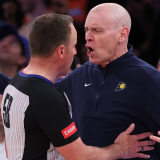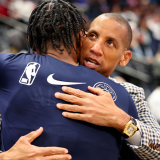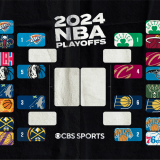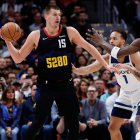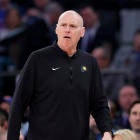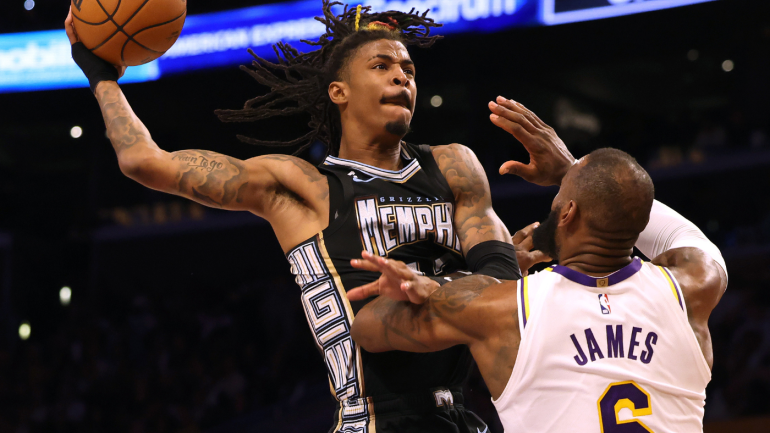
There is no good solution to defending Ja Morant, but all things considered, the Los Angeles Lakers have game-planned against him as well as they could reasonably be expected to. Jarred Vanderbilt starts games on him and Dennis Schroder picks up the assignment when Vanderbilt sits. Both do a bit of face-guarding when Morant doesn't have the ball in his hands. The Lakers sacrifice mid-range runway in exchange for rim integrity. Nobody chases Morant over screens.
Is it perfect? No. Morant can break any gameplan. Vanderbilt tried his luck against Morant as a member of the Minnesota Timberwolves last postseason and mostly failed. Morant scored 28 points in a single quarter against the Lakers less than two months ago relying mostly on the floaters the Lakers are willingly sacrificing right now. But the Lakers aren't equipped to stop Morant. They'll settle for containing him. For most of this first-round series, they've limboed under that low bar.
The Lakers held Morant to 18 points on 14 shots in Game 1. Through three quarters of Game 3, he had 21 on 4-of-13 shooting. The Lakers can live with those numbers. What they probably won't ever be able to endure again is a seven-minute stretch in which Morant scores 22 consecutive points for his team. He gave them such a run in the fourth quarter on Saturday, and it very nearly got the Grizzlies back into a game they trailed 35-9 after one quarter.
So how did he do it? He sprinkled in a number of points in ways that the Lakers couldn't control. There's nothing D'Angelo Russell can do against Morant in transition, for example.
Poor Austin Reaves gets caught on Morant in this transition cross-match. He's too slow to stay in front of him, like 90% of the league.
There were a few slightly more concerning moments. Morant beat Vanderbilt twice on the move. Once was in transition, when he caught Vanderbilt back-pedaling, and the other was in the half-court, where he used a behind-the-back dribble to shake him.
In a perfect world, the Lakers would have a defender that can consistently stick on Morant. Vanderbilt has done an admirable job, but he's also half-a-foot taller than Morant and he's the reactor, not the initiator. No one Vanderbilt's size is going to have fluid enough hips to change directions at Morant's speed on plays like these. The help could have been better, especially on the first play, which Davis hardly contests largely due to the wide scoring margin. But ultimately, these are superstar points. Chalk them up to being unable to stop Morant, but happily containing him for most of the night.
Where the Lakers should feel relatively comfortable, though, is in where the majority of those points came. Morant made four pull-up 3-pointers in seven minutes. Three of them were the result of the same strategic sacrifice from the Lakers. The fourth came in transition with a half-hearted contest.
The first likely involved an illegal screen by Jaren Jackson Jr., but neither Schroder nor Rui Hachimura made any sort of serious attempt to contest the look.
The second is a more traditional example of ducking under a screen. Morant takes the handoff from Tyus Jones and moves toward a Xavier Tillman screen. Schroder has two options at this point. He can go "over" the screen, meaning he would try to slip into the space between Tillman and Morant and chase his man down. Or, he can go "under" the screen, meaning he can occupy the space between Tillman and the basket and plan to meet Morant on the other side. You go over when you're so terrified of a shooter that you'd rather challenge him to a footrace to the basket. You go under when you want him to shoot. Schroder emphatically wants Morant to shoot. Morant just happens to make the shot.
Morant does have two sets of hands in his face on the third 3-pointer, but it is in transition. Neither Russell nor Reaves leave their feet to contest Morant, and he rattles in 3-pointer No. 3.
This half-hearted contest was the proper call. The moment Russell leaves his feet, he's not only vulnerable to a pump-fake, but he's far likelier to get call for a foul. That isn't a worthwhile risk on Morant.
Our fourth 3-pointer is similar to the second, only with Vanderbilt playing defense instead of Schroder. Jackson sets a screen, Vanderbilt ducks under it and Morant settles in for an open look.
Guarding Morant is a series of compromises. Giving up those shots is the simplest. Morant is unstoppable with a head of steam and devastating when he has space to launch floaters. But pull-up 3's? Those are shots any defense should be eager to give away. Morant made just 29.8% of the ones he took during the regular season. Sometimes, 29.8% shooters make four in a row.
Some coaches get skittish after a few makes and change their defense. The best ones tend to trust the law of averages. The Grizzlies themselves went through a version of this dilemma in Game 1. They frequently used Hachimura's defender to serve as extra help elsewhere on the floor. Hachimura made five 3-pointers in response. The Grizzlies weren't impressed. "I mean, that was our gameplan going in," Desmond Bane said at the time. "Make him hit shots and you know, he did. You know, tip your cap. It's probably the best game of his career. "It's a seven-game series. Let's see if he can do it again Wednesday."
Hachimura is still making his shots. Through three games he is now averaging 21.7 points on 67% shooting from the field against the Grizzlies. This approach can burn you with bad variance. But Hachimura isn't Morant. The Lakers have no way of stopping Morant consistently. His points are going to come one way or another. So the Lakers dared him to take them from deep. He succeeded in the fourth quarter of Game 3. And if that leads him to take more pull-up 3's in Game 4? The Lakers certainly won't complain about it.








